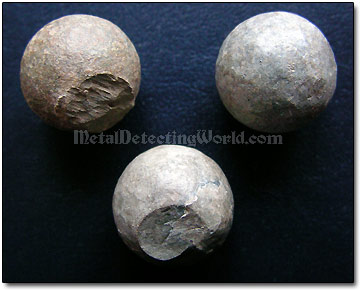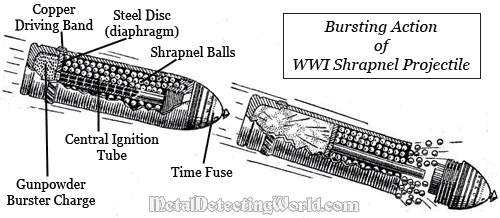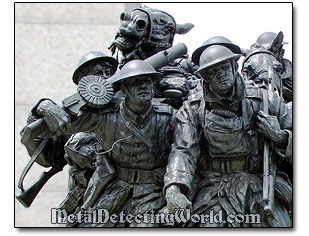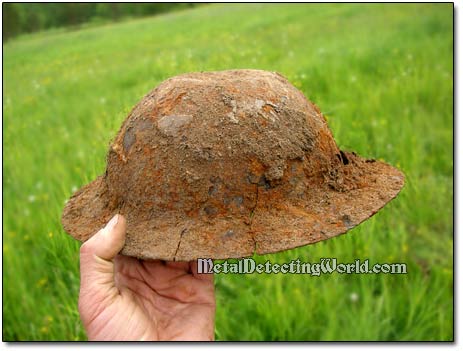Part I - WW2 Relic Hunting at the Swedish Tavern Site, page 33
Finding a Brodie Helmet and Lead Shrapnel Balls
I also recovered three lead shrapnel balls from the World War I. The antipersonnel projectile was invented by Major General Henry Shrapnel, an English artillery officer, in 1784. During the initial stages of World War I, shrapnel was widely used by all sides and was effective against troops in the open, particularly massed infantry (advancing or withdrawing).
The shrapnel projectile contained 1 pound of lead-antimony balls (41-42 pieces). A typical size of a single shrapnel ball was ½ inch (approximately 170 grains (11 g)). A bursting charge (about 150 - 200 feet per second) would scatter the balls as well as fragments of the shrapnel shell casing within 100 yards or more in any direction.
WW1 Lead Shrapnel Balls

At the velocity of a bursting charge, plus the additional velocity from the shrapnel projectile, the shrapnel balls would have enough energy to be lethal for the troops in the open. For larger guns which had lower velocities, correspondingly larger balls were used so that each individual ball was lethal.

From late 1914, most armies decreased their use of shrapnel shells as an anti-personnel weapon in favor of high-explosive shells. New tactical roles of shrapnel included cutting barbed wire and providing "creeping barrages" to both screen its own attacking troops and suppress the enemy defenders. The munition has been obsolete since the end of World War I for anti-personnel use.
It was not the first time I found the shrapnel balls in this region. To my knowledge, this area did not see any WWI battles, so I could not explain how the WWI battle relics wound up here. Back in June, while cache hunting at the different location which was not far away from this one, we received a cache-like signal, dug a deep hole (1m deep) and unearthed... the Brodie steel helmet of the First World War!
Brodie Helmet, ca. WWI, Was Found back in June

WWI Brodie Combat Helmet - Brief Historical Facts:
At the beginning of World War I, none of the participating armies were issued with any form of protection for the head other than cloth and leather caps. The French introduced the first of the modern steel combat helmets - Adrian helmets, in the summer of 1915. The British and Commonwealth troops followed with the Brodie helmet, which was also later worn by US forces, in the fall of 1915. And the Germans followed with the Stahlhelm in February 1916.

Brodie's design, patented in 1915 by the Briton John L. Brodie, resembled the medieval infantry "kettle hat" or chapel-de-fer, unlike the German Stahlhelm, which resembled the medieval sallet. The original design - Type A, was made of mild steel with a brim 1.5-2 inches wide. The Type A was in production for just a few weeks before the specification was changed and the Type B was introduced in October 1915.
The Brodie helmet was eventually worn by all the troops of Allied (Entente) Powers, and besides the official titles such as Mark I Helmet (in Britain) and M1917 Helmet (in the US), it had many nicknames: a "tin hat", a "battle bowler", "steel", "shrapnel helmet", "Tommy helmet" and "doughboy helmet."
The helmet's "soup bowl" shape was originally designed to protect the soldier's head and shoulders from fragmentation falling from above. The shallow bowl design allowed the use of relatively thick steel that could be formed in a single pressing while maintaining the helmet's thickness. None of the steel helmets introduced during the World War I era were intended to protect against bullets, but were primarily aimed at reducing head-wounds from shrapnel.
WWI Type A Rimless Brodie Helmet, ca. 1915
